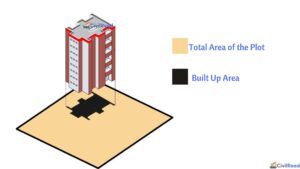Contents
What is FSI?
The full form of FSI is the “Floor Space Index” and it is the ratio of the total area of the plot to the built-up area on the plot. FSI is a rule followed in the development control norms of many cities. It directly tells us about permissible floor areas that can be built upon on a given plot. FSI is also called Space ratio, plot ratio and area ratio.

FSI Formula
Floor Space Index = (Total Area of all the Floors of Building / Total Plot Area of Building)
Different cities have different FSIs. The FSI value is regulated or decided by the DTCP (Directorate of Town and Country Planning ) Dept. The DTCP gives different permissible FSI values based on the following factors.
Importance of FSI in Building Construction
FSI value influences the value of land in an area. The FSI value is local and varies from region to region. More the FSI values, the more the utilization of space. Ultimately, less the property’s price. Because, the contractor can build more and the builder will sell more, and thus they will charge a reasonable fee from the home buyer.
FSI allows you to construct the building as per the rules and regulations. If the building plan is prepared with the knowledge of FSI, approval and NOC will not be questioned if you know the floor space index for the first time.
Permissible FSI value depends on the following factors:
- Size of the plot and location of the plot (is it urban or rural etc)
- Purpose of the building ( commercial building or residential apartment or industry etc.).
- The width of the side road.
- Availability of electricity, water and sewer lines.
- Type of building:
- Ordinary building (max of two floors)
- Special building ( min of 2 floors and max of 4 floors)
- Multi storeyed building (more than 4 floors)
Also Read:
What is Buildup Area and Plot Area?
What is FAR?
Both FSI and FAR are the same. FAR means Floor Area Ratio. FSI is expressed as an index and FAR as a ratio. FSI of 1.8 is termed as FAR of 180% (FAR 180)
FAR = FSI x 100
How to Calculate Built-up area of A Building using FSI:-
Let’s say you have 3000 square feet of plot and you want to build a Multi storeyed building on that land for commercial purposes.
Based on the type and purpose of construction, obtain the FSI value of your plot from your state or province official govt website.
Let us consider the FSI value obtained from government for your location of the plot and type of construction is 2.
FSI formula = Total built up area / Total plot area Total Builtup area = FSI x Total plot area
FSI = 2, Total Plot area = 3000sft
Total Built Up area = 2×3000 = 6000sft.
The multi-storied building has a minimum of 5 floors
Considering 5 floors construction 6000/5 =1200Sft
if you are considering the 6 floors construction, each floor area should not exceed more than 1000Sft.
What Is Premium FSI?
Premium FSI is also called as Paid Floor Space index. If your plot stands in a place of limited FSI ( less FSI) and you want to extend the allowable permissible area of construction then you can opt for Premium FSI paying additional charges to local authorities. But, to be eligible for this option, the width of the road adjacent to your land must be more than 30 feets.
30 – 40 Feet Road Width 20% Premium FSI 40 – 60 Feet Road Width 30% Premium FSI Greater 60 Feet Road Width 30% Premium FSI
which means, if your land adjacent to the road has a width of 30-40 feet, you can apply the option of 20% premium FSI which means you can build 20% more than the allowable FSI.
Example:
Suppose you are planning to construct a building in the land of 2000 fts which is located near 60ft road where your normal FSI obtained from local authorities is 1.5. then you can extend the premium FSI by 40%
Built Up area = (FSI+40% extra of FSI) x Total Plot area
= (1.5 + 1.5×40/100) x 2000
= (2.1) x 2000
= 4200sft
Advantages and Disadvantages of Floor Space Index:
Advantages:
- F.S.I can be considered as a ban on construction, but it has many advantages for the city.
- It helps in maintaining the proportion of open space and built-up space in an area.
- This ensures a clear horizon for the area.
- Good FSI values ensure the good development of the project.
- It helps to maintain a balance between continuous, planned growth and development.
Disadvantages:
- The Lower Floor Space Index imposes restrictions on the development of the city.
- If the floor space index is too high, it results in non-eco-friendly and haphazard development of the city.
- For lesser FSIs, Utilization decreases and the price of property increases.
Most Important:
- What is Plot area, Carpet Area, Setback area, Plinth Area, Buildup Area
- Learn about 16+ Different types of Slab
- Know about Different types of columns used in construction
Different Types of footings used in construction all at one place. Where to Use? When to Use?

